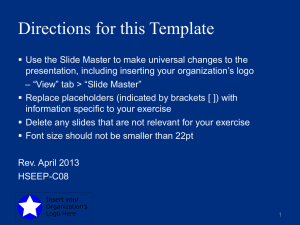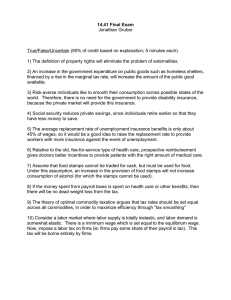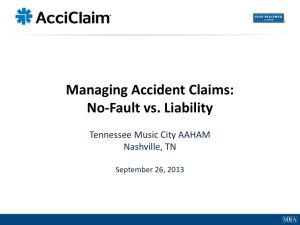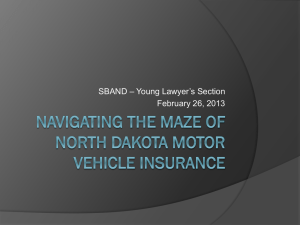CHAPTER 1 INTRODUCTION reform in the United States.
advertisement
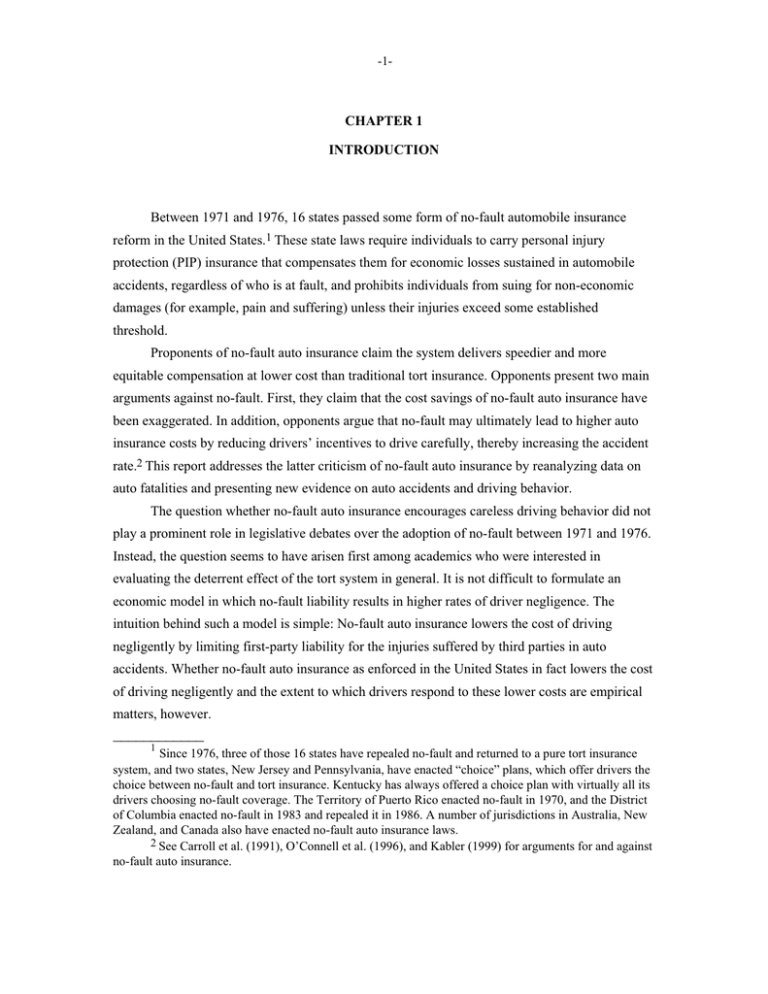
-1- CHAPTER 1 INTRODUCTION Between 1971 and 1976, 16 states passed some form of no-fault automobile insurance reform in the United States.1 These state laws require individuals to carry personal injury protection (PIP) insurance that compensates them for economic losses sustained in automobile accidents, regardless of who is at fault, and prohibits individuals from suing for non-economic damages (for example, pain and suffering) unless their injuries exceed some established threshold. Proponents of no-fault auto insurance claim the system delivers speedier and more equitable compensation at lower cost than traditional tort insurance. Opponents present two main arguments against no-fault. First, they claim that the cost savings of no-fault auto insurance have been exaggerated. In addition, opponents argue that no-fault may ultimately lead to higher auto insurance costs by reducing drivers’ incentives to drive carefully, thereby increasing the accident rate.2 This report addresses the latter criticism of no-fault auto insurance by reanalyzing data on auto fatalities and presenting new evidence on auto accidents and driving behavior. The question whether no-fault auto insurance encourages careless driving behavior did not play a prominent role in legislative debates over the adoption of no-fault between 1971 and 1976. Instead, the question seems to have arisen first among academics who were interested in evaluating the deterrent effect of the tort system in general. It is not difficult to formulate an economic model in which no-fault liability results in higher rates of driver negligence. The intuition behind such a model is simple: No-fault auto insurance lowers the cost of driving negligently by limiting first-party liability for the injuries suffered by third parties in auto accidents. Whether no-fault auto insurance as enforced in the United States in fact lowers the cost of driving negligently and the extent to which drivers respond to these lower costs are empirical matters, however. ____________ 1 Since 1976, three of those 16 states have repealed no-fault and returned to a pure tort insurance system, and two states, New Jersey and Pennsylvania, have enacted “choice” plans, which offer drivers the choice between no-fault and tort insurance. Kentucky has always offered a choice plan with virtually all its drivers choosing no-fault coverage. The Territory of Puerto Rico enacted no-fault in 1970, and the District of Columbia enacted no-fault in 1983 and repealed it in 1986. A number of jurisdictions in Australia, New Zealand, and Canada also have enacted no-fault auto insurance laws. 2 See Carroll et al. (1991), O’Connell et al. (1996), and Kabler (1999) for arguments for and against no-fault auto insurance. -2- The empirical literature has focused almost exclusively on the relationship between nofault and fatal accident rates. Landes (1982) first explored this issue, finding that the adoption of no-fault auto insurance increased fatal accident rates by as much as 10 percent annually in nofault states between 1971 and 1975. This finding prompted a trio of studies in the early 1980s (Zador and Lund, 1986; Kochanowski and Young, 1985; U.S. Department of Transportation, 1985), which all came to the opposite conclusion that no-fault has no effect on fatal accident rates. More recently, several studies have revisited the question with data from Australia, New Zealand, and Canada, as well as more recent data for the United States (Devlin, 1992; McEwin, 1989; Cummins and Weiss, 1999; Cummins, Weiss, and Phillips, 1999; Kabler, 1999).3 These more recent studies have all found evidence in favor of the hypothesis that no-fault leads to higher fatal accident rates. That no-fault insurance could alter driving behavior enough to cause fatal accident rates to be as much as 10 percent higher than they might otherwise be is a striking conclusion, and one that has had a significant effect on recent debates over no-fault. A commonly made argument against no-fault is that individuals should be held accountable for their negligent actions. A tort system provides redress for those injured and serves to deter negligent actions overall. No-fault insurance, opponents reason, weakens this deterrent effect and so should significantly increase accident rates. Consumer organizations, academics, and public officials have made this point in both the popular press and academic literature in arguing against federal auto choice legislation that would allow consumers to choose between tort and no-fault liability (Association of Trial Lawyers of America, 2000; Priest, 1998; Nader, 1999). If we take the findings of Landes (1982), Devlin (1992), and Cummins, Weiss, and Phillips (1999) at face value, no-fault led to as many as 5,600 additional highway fatalities in nofault states between 1991 and 1995 alone. If true, it is hard to justify the adoption of no-fault insurance. I think these numbers are implausibly large, however, and I believe the results of the present study show convincingly that not only does no statistically significant relationship exist between the adoption of no-fault and fatal accident rates but also no statistically significant relationship exists between no-fault and accident rates overall or other measures of driver care. I argue further that no-fault auto insurance as implemented in the United States, even in its strictest form, is unlikely to significantly lower the expected cost of an auto accident to the at-fault driver. So, even a priori, it seems unlikely that no-fault auto insurance could have a substantive impact on driver behavior. ____________ 3 Cummins, Weiss, and Phillips (1999) is a revised version of Cummins and Weiss (1999). In the remainder of this report, I refer only to the former. -3- In Chapter 2 of this report, I provide a general explanation of the differences between nofault and tort insurance and how these differences, in principle, could affect driving behavior. I then offer in Chapter 3 three tests of whether no-fault affects driving behavior and outcomes. Chapter 3 reviews the empirical literature on the relationship between no-fault and the fatal accident rate focusing on econometric weaknesses that cast serious doubt on the conclusions of previous studies. I then test the hypothesis that no-fault auto insurance leads to higher fatal accident rates using state-level data that span the period over which no-fault was first implemented in the United States. Even if no-fault has no discernible impact on the fatal accident rate, no-fault could nevertheless affect the overall accident rate and the propensity to drive negligently more generally. Therefore, in Chapter 3, I test whether such relationships exist using data not previously employed to study the impact of no-fault. I then offer some concluding remarks in Chapter 4.
